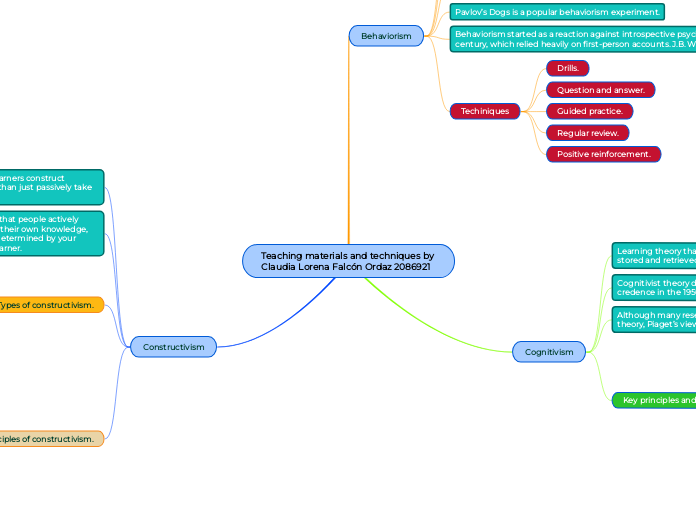Teaching materials and techniques by Claudia Lorena Falcón Ordaz 2086921
Behaviorism
Teachers use behaviorism to show students how they should react and respond to certain stimuli.
the behavioral learning theory is key in understanding how to motivate and help students.
Motivation plays an important role in behavioral learning. Positive and negative reinforcement can be motivators for students.
Pavlov’s Dogs is a popular behaviorism experiment.
Behaviorism started as a reaction against introspective psychology in the 19th century, which relied heavily on first-person accounts. J.B. Watson and B.F.
Techiniques
Drills.
Question and answer.
Guided practice.
Regular review.
Positive reinforcement.
Cognitivism
Learning theory that focusses on how information is received, organized, stored and retrieved by the mind.
Cognitivist theory developed as a reaction to Behaviorism and gained credence in the 1950s.
Although many researchers contributed to the development of the learning theory, Piaget’s views had a tremendous impact.
Key principles and classroom implications
Learning is a process of organizing information into conceptualized models
Retention and recall is important to build schema’s in the brain.
Memory is supported by organizing learning material.
Teachers must provide tools that help learner’s brain process information.
Constructivism
Theory that says learners construct knowledge rather than just passively take in information.
Based on the idea that people actively construct or make their own knowledge, and that reality is determined by your experiences as a learner.
Types of constructivism.
Cognitive
Social.
Radical.
Subtopic
Principles of constructivism.
Knowledge is constructed.
People learn to learn, as they learn.
Learning is an active process.
Learning is a social activity.
Learning is contextual.
Knowledge is personal.
Learning exists in the mind.
Motivation is key to learning.
